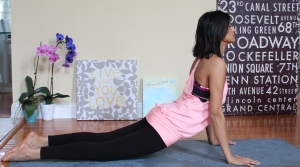
Your age is not determined by the number of years, but by the flexibility of your spine.
Think about your functional daily activities: brushing your teeth, washing dishes, reading, playing with your kids, working on the computer. The theme of your day is the Hunchback of Notre Dame, bent over and flexed forward!
Quick anatomy lesson: your back is made up of irregular bones called vertebral bodies. These bodies stack up on top of one another with intervertebral discs in between them. The discs function to absorb shock, support the bones, and allow increased mobility of the spine. The disc is made up of a center, called the nucleus pulposus, which consists of a semifluid mass. The nucleus is surrounded by collagen fibers. The posterior portion of the disc has thinner fibers compared to the rest of the disc. Making the disc more vulnerable in the back portion.
Increased forward bending of the spine, creates gapping in the back of your spine. Making it easier for the disc to leak out and cause disc herniations or disc bulging. The disc can then put pressure on nerves, causing you to have tingling, numbness, even a pins and needles feeling down your legs. Over time, if these discs keep pushing on the nerves, your muscles can become weak and cause limitations in function.
Maybe you’re thinking I don’t have any back pain. Well I’m saying, Not Yet!
8 out of 10 (80%) people in the USA claim to have back pain at some point in their lives.1 Total cost on healthcare, ranges in the billions, for low back pain in one year.2 This is the largest of any other disease for which analysis is available.3
Oh and it gets worse. Of those people who report back pain, 73% have a reoccurrence within 12 months.4
Repeated flexion of the spine puts strain on your back. If the repetitions are close enough, the back does not recover to full mobility causing imbalances in flexibility, leading to pain.
Test it: turn to one side and look in the mirror. Place your hand on the small of your back and bend backwards, that’s extension of your spine. Look at how far you can extend. Now bend forward 15-20 times in a row, go as far as you can like you are trying to touch your toes. Then check your extension again in the mirror. You will probably have less mobility, and/or you now have some aching in your back. Imagine if you are doing this all day everyday, which you are. The limitations you create are much greater.
The proof is in the research. Compression caused by loading the spine during activities like weight-bearing or bending forward causes about 10% water loss of a disc in one day.6 Which results in about 2% height loss during the day.7 Although your disc rehydrates once compression is released and overnight. The viable cells you have to help this process decrease with age.
You have 98% viable cells in infancy, 50% in young adults, and only 20% in elderly. This is why people get shorter as they age.9 Unfortunately, no one has found the youth fountain so yes, this will happen to you. So whether you are 12 years old or 60 start preventing low back pain.
Need more convincing? In the early morning your back is 300% stiffer to flexion forces, and is at the highest risk for injury from bending forward.8 This is why brushing your teeth is the most complained about activity for people with back pain and can very easily injure your back.
Prevention Tip: open the door of the cabinet under your sink and place one foot up onto the shelf, while you brush. This allows for you to use your hip to flex forward, protecting your back.
7 out of 8 research trials found only extension exercises were effective in preventing low back problems.10
Watch the Video to Stay Flexible. Stay Young. Practice Prevention!
Note: This may not be for everyone especially people with anterior disc issues or spinal stenosis. If you already have back pain, use caution and don’t continue if you get increased pain or stiffness.
References:1.Medline Plus. Back Pain. http://www.nlm.nih.gov/medlineplus/backpain.html. Accessed March 11, 2013
2.Mehra M, Hill K, Nicholl D, Schadrack J. “The burden of chronic low back pain with and without a neuropathic component: a healthcare resource use and cost analysis.” J Med Econ. 2012;15(2):245-52
3. Maniadakis N, Gray A. The economic burden of back pain in the UK. Pain 84 (2000) 95-103
4. Liset H M Pengel, Robert D Herbert, G Maher, Kathryn M Refshauge. Acute Low Back Pain: systematic review of its prognosis. BMJ 2003;327:323
5. Hirsch C, Nachemson A. New observation on mechanical behaviour of lumbar discs. Acta Orthop Scandinav 1954;23:254-283.
6. Brown T, Hansen RJ, Yorra AJ. Some mechanical tests on the lumbosacral spine with particular reference to the intervertebral discs. J Bone Join Surg 1957, 39A:1135-1164.
7. Stokes IAF. Surface strain on human intervertebral disc. J Orthop Res 198, 5:348-355.
8. Adams MA, Dolan P, Hutton WC. Diurnal variations in the stresses on the lumbar spine. Spine 1987 March;12(2): 130-7. 9. Buckwalter JA. Spine update. Aging and degeneration of the human intervertebral disc. Spine 1995; 20:1307-1314. 10. Bigos SJ, Holland J, Holland C, Webster JS, Battie M, Malmgen JA; High-quality controlled trials on preventing episodes of back problems: systematic literature review in working-age adults. Spine J;9:147-168, 2009.
